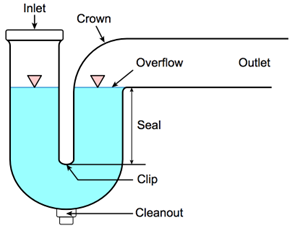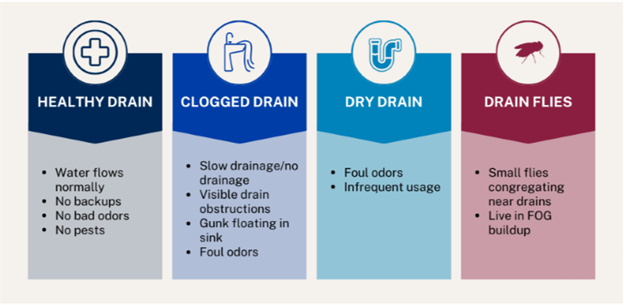How Do I Know If I Have a Drain Problem?
How Do I Know If I Have a Drain Problem?
So, your drain has been acting weird. Water has been taking longer to flow, and dishes have been a nightmare. The staff has been complaining of a foul odor every time they enter the kitchen. There’s visible gunk floating around the sink. It’s an all-around nasty situation, and you aren’t sure what’s causing it, but you need answers—you're starting to get worried about health department guidelines.
One thing is pretty certain: if you’re looking up whether you have a drain problem, it’s a safe bet that you probably have one.
State Chemical sells drain care solutions for drain clogs, drain flies, drain odors, and dry drain, as well as products for preventative drain maintenance. We see a lot of different drain issues in our line of work, and we want you to know that there’s a solution for you. But first, you need to diagnose your problem.
In this article, we’ll cover symptoms of common drain problems so you can learn what issue your facility is dealing with. You’ll be ready to take the first step toward a resolution from there.
Here are the issues we’ll cover:
- What Should a Healthy Drain Look Like?
- Why is My Sink Draining So Slowly?
- What Do Foul Odors Indicate?
- Why are There So Many Gnats Around My Sink?
What Should a Healthy Drain Look Like?
You’re probably experiencing what an unhealthy drain looks like, but what should your drain look like?
A healthy drain is one that water easily flows through without backing up. It won’t have foul odors or pests. If you look at it, smell it, or touch it, you won’t notice anything unusual. You won’t think twice about it or notice any quirks.
Your drain isn’t exhibiting this image. So, what do its symptoms point to?
Why is My Sink Draining So Slowly?
Slow sink drainage can look like water that takes longer to drain or doesn’t drain at all. If this is what you’re experiencing, you’re probably dealing with some kind of buildup.
Often, this is a buildup of fats, oils, and greases (FOGs). Whenever FOGs go down your drain, they cause buildup by clinging to the sides of your pipes. It might look like gunk floating up in your sink, visible obstructions down the drain, or even just slow-flowing water. To some extent, this is an unavoidable and common problem to have. Even if you don’t know that it’s caused by FOGs, blockages and buildup will be obvious based on the signs you observe, and that’s something you can treat.
You can prevent FOG buildup and clogs in obvious ways, like having a grease trap or not dumping fryer oil down your sink. However, if any amount of soap scum, grease, or otherwise goes down your drain, buildup will happen. It’s impossible to fully eliminate the risk.
If you believe you’re dealing with FOG buildup or a clog, your next steps are to explore drain openers or drain snakes to remove buildup and get your drain back in working order.
What Do Foul Odors from My Drain Indicate?
There are several possible causes for foul odors in your drain. To know the answer here, we’ll have to ask more questions:
Are Foul Odors the Main Symptom?
So, let’s consider all the factors in this situation. Water is draining normally, there doesn’t appear to be a blockage, there are no floating particles or visible gunk. But every time you walk past the drain, it smells very, very bad.
In this situation, you’re likely dealing with dry drain. This happens when your sink’s P-trap (the squiggly pipe running underneath it) doesn’t have enough water in it. Water is typically what blocks the sewer gases from escaping into your facility since the gases can only travel through the air. In a healthy P-trap, there’s a high enough level of water in the pipe so that sewer gases are blocked. When that level gets to be low, often from underuse, the sewer gases get through your pipes and enter the air, causing these foul odors.
However, it’s important to be sure that dry drain is the real issue before you diagnose it. If you’re unsure, it’s a good idea to call a professional to survey the drain and make a final call. But if this is what you’re dealing with, you should buy a dry drain treatment product. State Chemical’s product, Shut Your Trap, is an example of this, floating on top of the water in your P-trap to slow evaporation. Slower evaporation, of course, means that it’ll take longer for the water level to get low so that sewer gases don’t escape.
Is Your Drain Also Experiencing Obvious Buildup?
But what if foul odors aren’t your drain’s only visible problem? These symptoms aren’t always mutually exclusive. If you’re experiencing bad smells paired with slow drainage, you could also be looking at FOG buildup. This is why having a professional survey the drain is important if you’re not completely sure what you’re dealing with. One symptom can mean different things depending on the context.
Why are There So Many Gnats Around My Sink?
You may be noticing an excess of fruit flies buzzing around in the kitchen or lounging on the walls and counters. This could be something you didn’t even realize was tied to your drain, but if it’s localized around one, there’s a good chance that those aren’t fruit flies but drain flies.
To the human eye, fruit flies and drain flies look the same, but if you put them under a magnifying glass, you would see that they’re biologically distinct. For example, drain flies have larger wings than fruit flies and appear fuzzy. Identifying which insect you’re dealing with might help you to more effectively deter them from your facility.
What Causes a Drain Fly Problem?
So, if upon closer inspection you are dealing with drain flies, how did they even get there? Well, it goes back to FOGs. On top of causing buildup and clogs, FOGs attract drain flies. They provide a habitat for drain flies within drains, as well as a food source.
Some people think they can eliminate drain flies by pouring pesticides down the drain. You shouldn’t do this anyway because of the risk of contaminating the water supply, but this actually doesn’t kill drain flies either. Drain flies burrow into FOG buildup on the sides of the pipes, and pesticides won’t get through the buildup.To get rid of drain flies, you have to eliminate their habitats.
So, How Do You Eliminate Drain Fly Habitats?
One method is to pour boiling water down the drain, which will melt FOGs. This will not work for FOG buildup further down the drain and is not recommended if you’re experiencing a serious problem. However, it can be effective for minor situations.
To most effectively remove drain fly habitats, use a more heavy-duty product like State Chemical’s NO Contest. This product clears FOG buildup and therefore removes both the drain flies’ food source and habitat, acting as a longer-lasting solution.
So, What’s Next?
It can be tough to know for sure what your drain’s issue is. You now know what symptoms might lead you to what conclusions, so you’re ready to research solutions to your problem. As you look for the best treatment for your situation, learn about how to choose a drain cleaning company.











